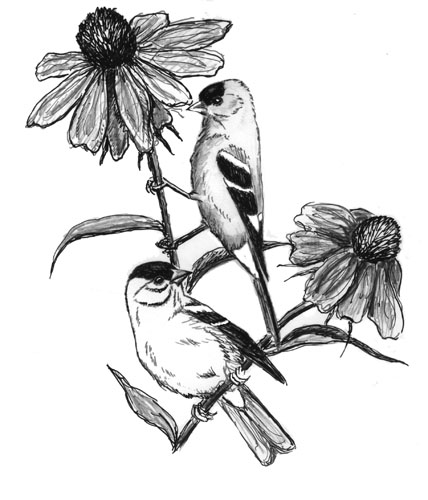
Dear Bird Folks,
We have been away in Florida all winter and now we are having trouble getting birds to come back to our feeders. Specifically, the finches are totally ignoring the thistle. Are the birds mad at us for leaving?
– Neil, Chatham, MA
Too bad for you, Neil,
You missed the best winter ever. While you were sitting in that endless Florida traffic, we were back here snuggling by the fire, drinking hot chocolate and reading lots of good books. We also shoveled and shoveled, and shoveled some more. It was hard work but wait until you see us on the beach. We are all super buff from doing all that shoveling. Of course, after being trapped inside for the past six months, we are also super pale. But I’m always like that, so it’s normal for me.
Just about everything in this country now has an expiration date on it, including beer, dog food and Crisco (Crisco?). But for some reason no one talks about birdseed becoming too old. How old is too old for birdseed? I know don’t know because no one talks about it. I often suggest to those who flee to Florida each winter that they use all their seed before leaving and not store it until spring. (They could also give their extra seed to a neighbor, but I cringe at the thought of anyone giving away free birdseed.) Will the seed turn bad? Leftover sunflower seed should be all right, even after sitting around all winter. If it looks okay and smells okay, then it’s probably okay to use. However, this does not apply to thistle seed. Thistle seems to have a fairly short shelf life. Why so short? It’s the government’s fault…of course.
What we call “thistle” is in fact niger seed (sometime stylized as “Nyjer” by companies that don’t think Americans can read English). Niger is native to and imported from Africa and Asia, where it is grown for cooking oil. Somewhere along the way it was discovered that goldfinches and other birds also enjoyed niger seed. Today nearly sixty percent of all niger is exported to support the bird food industry. However, this popular birdseed was almost kept out of the U.S. Back in 1982, which was long before I was born, a ship loaded with niger was found to also contain “dodder” seeds. Dodder is a parasitic plant that the USDA definitely doesn’t want coming in to this country. The entire shipment was about to be rejected, when the USDA’s E. George Strasser entered the picture. George knew that dodder seeds have a high moisture content, so he suggested that the entire batch of seed be heated to 212 degrees. The heat cooked-off all the moisture in the dodder seed, thus sterilizing it. Thanks to George, thistle is now safe to import. That’s the good news. The bad news is that the intense heat appears to have affected the thistle. Now if thistle is allowed to sit around for too long, it dries out and becomes unappetizing…just like Crisco.
How can you tell if your thistle is bad? It’s easy; the birds won’t eat it. This is why I encourage folks to only buy small amounts at a time. And for goodness sake, don’t stock up on thistle just because some store has put it on sale. (There’s a good reason why it’s been marked down). Here’s something else you should know about this seed. Some folks are concerned when they see a lot of black seeds beneath their thistle feeder. They think the birds are rejecting or spitting out bad seeds. In fact, seeing black under your thistle feeder is like burping at the dinner table in China. It seems wrong but it’s actually a good thing. Remember, birds don’t eat the whole seed; they only eat the “meat” inside. The black on the ground is mostly empty shells.
Because thistle tends to cost more than most other seeds, people hate to waste it. As result, they don’t rotate the food in their feeders. This is a big mistake. Old seed left at the bottom of the feeder will gather moisture, turn moldy and eventually infect the fresh seed. I’ve had customers bring in their thistle feeder because the birds have stopped coming. They fail to notice the grossness of the seed inside. The bottom of their feeder looks like an experiment with penicillin. Remember: never, ever top-off your feeder…unless you are trying to discover a cure for some exotic disease, like jungle fever or cooties.
The next question is: With all the hassles, is thistle worth using? Yes, of course it is. (What would you expect me to say?) A little of this seed goes a long way. A five-pound bag will probably last you a few weeks, while five pounds of sunflower seed won’t last an afternoon. Plus, thistle is just for small birds. It’s the perfect alternative for all the bird bigots who have issues with grackles, crows and jays. In addition to goldfinches, wintering siskins and redpolls also enjoy thistle. And for a short period at the end of summer, chickadees also go for it. Don’t ask me why they only like it in late summer. Perhaps they just want to taste something imported for a change.
No, the birds aren’t mad at you for spending the winter in Florida, Neil. A lot of their friends do the same thing. I suggest you clean out your feeder, fill it with fresh seed (seed that’s been newly purchased, not scooped from the same old batch) and all will be forgiven. I’d write more on this topic, but I have to run home. Suddenly, I’m worried about the date on my can of Crisco.